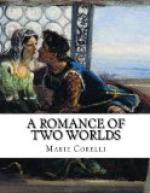I speak of as
artists are those who work day and
night to attain even a small degree of perfection,
and who are never satisfied with their own best efforts.
I was one of these some years ago, and I humbly assert
myself still to be of the same disposition; only the
difference between myself then and myself now is, that
then I struggled blindly and despairingly, and
now I labour patiently and with calmness, knowing
positively that I shall obtain what I seek at the
duly appointed hour. I was educated as a painter,
mademoiselle, by my father, a good, simple-hearted
man, whose little landscapes looked like bits cut
out of the actual field and woodland, so fresh and
pure were they. But I was not content to follow
in the plain path he first taught me to tread.
Merely correct drawing, merely correct colouring,
were not sufficient for my ambition. I had dazzled
my eyes with the loveliness of Correggio’s ‘Madonna,’
and had marvelled at the wondrous blue of her robe—a
blue so deep and intense that I used to think one
might scrape away the paint till a hole was bored
in the canvas and yet not reach the end of that fathomless
azure tint; I had studied the warm hues of Titian;
I had felt ready to float away in the air with the
marvellous ’Angel of the Annunciation’—and
with all these thoughts in me, how could I content
myself with the ordinary aspiration of modern artists?
I grew absorbed in one subject—Colour.
I noted how lifeless and pale the colouring of to-day
appeared beside that of the old masters, and I meditated
deeply on the problem thus presented to me. What
was the secret of Correggio—of Fra Angelico—of
Raphael? I tried various experiments; I bought
the most expensive and highly guaranteed pigments.
In vain, for they were all adulterated by the dealers!
Then I obtained colours in the rough, and ground and
mixed them myself; still, though a little better result
was obtained, I found trade adulteration still at
work with the oils, the varnishes, the mediums—in
fact, with everything that painters use to gain effect
in their works. I could nowhere escape from vicious
dealers, who, to gain a miserable percentage on every
article sold, are content to be among the most dishonest
men in this dishonest age.
“I assure you, mademoiselle, that not one of
the pictures which are now being painted for the salons
of Paris and London can possibly last a hundred years.
I recently visited that Palace of Art, the South Kensington
Museum, in London, and saw there a large fresco by
Sir Frederick Leighton. It had just been completed,
I was informed. It was already fading! Within
a few years it will be a blur of indistinct outlines.
I compared its condition with the cartoons of Raphael,
and a superb Giorgione in the same building; these
were as warm and bright as though recently painted.
It is not Leighton’s fault that his works are
doomed to perish as completely off the canvas as though
he had never traced them; it is his dire misfortune,




